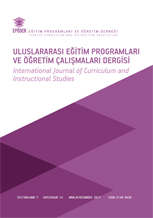An evaluation of Cappadocia vocational college two-year restoration curriculum
Abstract
Higher vocational education, a crucial pillar of higher education, aims at providing individuals with the vocational knowledge and skills to enable them to be semi--‐‑qualified productive and adaptable members to the requirements of era by delivering curricula designed in accordance with labor market demands. By its nature, any delivered curricula are subject to evaluation in relation to achieving their goals, their functioning, reaching desired knowledge, skills and attitudes. This study aimed to evaluate the curriculum of Restoration department at Cappadocia Vocational College in Nevşehir, offered to contribute to the protection of natural and historical sites, and to meet employers’ demands in the region. Participants of the study were students (n=28), instructors (n=7), employers (n=4), and graduates (n=6). The study was based on stakeholders’ opinions on curriculum assessed through questionnaires and interview sobjectives evaluation model and goal--‐‑free evaluation model. Data were analyzed by using statistical methods and content analysis method. Results indicated that students felt incompetent at the end of the program. Additionally, although some outcomes were found useful for worklife, unintended outcomes like indiscipline were estimated by stakeholders to pose problems during the worklife. Finally, it was found necessary to revise the program for remedying technical and equipment shortages.
Downloads
References
Business, Industry and Higher Education Collaboration Council. (2007). Graduate employability skills.
Commonwealth of Australia. Precision Consultancy. Canadian Labour Force Development Board. (1994). Putting the pieces together: towards a coherent transition system for Canada'ʹs labour force. Ottawa: CLFDB.
Cohen, A. M., & Brawer, F. B. (2003). The American community college. John Wiley & Sons. Education Research Foundation of Turkey (TEPAV), (2007). Higher education and labour market in Turkey. TEPAV, Ankara.
Fitzpatrick, J. L., Sanders, J. R., & Worthen, B. R. (2004). Program evaluation: Alternative approaches and practical guidelines (3rdedt.). USA: Pearson Publication.
Fraenkel, J. R., & Wallen, N. E. (2006). How to design and evaluate research in education. New York: McGraw--‐‑ Hill.
Gredler, M. E. (1996). Program evaluation. USA: Pearson Education Company.
Harvey, L. (2000). New realities: the relationship between higher education and employment. Tertiary Education and Management, 6, 3--‐‑17.
Krippendorff, K. (2004). Content Analysis: An Introduction to Its Methodology. 2nd ed. Thousand Oaks, CA: SAGE Publications.
Krueger, W.,J., & Casey, V. L. P. (2011). Designing and conducting mixed methods research (2nded). Thousand Oaks, CA. SAGE Publications
Lederer, J. E. (2005). Promoting Lifelong Learning: An Analysis of Community College Delivery of Employer--‐‑Focused Education and Training. Retrieved from ProQuest Dissertations & Theses.
Miles, M., & Huberman, A. M. 1994. Qualitative data analysis. Thousand Oaks, CA: SAGE Publications. National Qualifications Institution(NQI) (2013). National qualifications of conservation and restoration staff (Level 4). Retrieved from http://www.myk.gov.tr/images/articles/editor/2013/ 210113/Tarihli_Eser Koruma_ve_Restorasyon_Elemani_seviye_4.pdf on April, 2013.
OECD. (2008). Education at a Glance. OECD Publishing.
Ozmon, H. A., & Craver, S. M. (2007). Philosophical foundations of education (8th Ed.). Columbus, OH: Merrill Publishing Co.
Sarıkaya, Y. (2011). Investigating stakeholders’ perceptions of employability factors: Evidence from a vocational college in Nevşehir. [Paydaşların istihdam edilebilirlik faktörlerine ilişkin algılarının incelenmesi: Nevşehir’de bir yüksekokulu örneği]. Unpublished master thesis, Middle East Technical University, Ankara. Schiro, M. (2008). Curriculum theory: Conflicting visions and enduring concerns. Los Angeles/ London: SAGE.
SVET (2006): Strengthening the role of the social partners and social dialogue in the vocational education and training system in turkey (Policy Paper). SVET, Ankara
Tashakkori, A. & Eddie, C. (2002). Handbook of mixed methods in social & behavioral research. Sage Publications. The Secretary'ʹs Commission on Achieving Necessary Skills. (1991). What work requires of schools: a scans report for America 2000. US Department of Labor, Washington.
Tsang, C. Mun (1997). The cost of vocational training. International Journal of Manpower, 18(1/2), 63--‐‑89.
TÜSİAD (Turkish Industry and Business Association). (1999). Restructuring vocational and technical education. TUSİAD--‐‑T / 99--‐‑2 / 252.
World Bank (2002). Global competitiveness report. World Economic Forum.
Ziderman, A. (1997). National programmes in technical and vocational education: Economic and education relationships. Journal of Vocational Education and Training, 49(3), 351--‐‑366.





